Stepper Motor - 29 oz.in (200 steps/rev, Threaded Shaft)
These steppers have a threaded shaft, which allows them to be used as a linear actuator. As the motor runs, it moves along the shaft at a specific rate of 1cm per 5 full rotations. These are a good choice for linear motion where precision and repeatability are important.
Note: It looks like the datasheet for this stepper may not be accurate. When connecting this motor to a bi-polar driver you'll want to wire it according to the wiring diagram in the documents below.
- Step Distance: 0.01mm
- 2-Phase
- Rated Voltage: 12V
- Rated Current: 0.4A/Phase
- 100mm Long Threaded Shaft (keyed on one end)
- Holding Torque: 21 N.cm
- 6-Pin Wiring Harness Included
- NEMA 15
Stepper Motor - 29 oz.in (200 steps/rev, Threaded Shaft) Product Help and Resources
Easy Driver Hook-up Guide
May 5, 2015
Get started using the SparkFun Easy Driver for those project that need a little motion.
Core Skill: Robotics
This skill concerns mechanical and robotics knowledge. You may need to know how mechanical parts interact, how motors work, or how to use motor drivers and controllers.
Skill Level: Experienced - Your experiences should include working with stepper motors and feedback system. You may need to understand how encoders and more complex control systems work.
See all skill levels
Core Skill: Electrical Prototyping
If it requires power, you need to know how much, what all the pins do, and how to hook it up. You may need to reference datasheets, schematics, and know the ins and outs of electronics.
Skill Level: Competent - You will be required to reference a datasheet or schematic to know how to use a component. Your knowledge of a datasheet will only require basic features like power requirements, pinouts, or communications type. Also, you may need a power supply that?s greater than 12V or more than 1A worth of current.
See all skill levels
Comments
Looking for answers to technical questions?
We welcome your comments and suggestions below. However, if you are looking for solutions to technical questions please see our Technical Assistance page.
Customer Reviews
2.8 out of 5
Based on 5 ratings:
2 of 2 found this helpful:
Can't reach rated torque; poor engagement between shaft and motor
I tried this out with a big easy driver, dialed in the current to 400 mA, and it couldn't even consistently move the shaft against gravity, much less move the 5 N load I intended.
If I step the motor in one direction, and the shaft moves down relative to the fixed motor housing. Step it in the other direction, the unloaded shaft still moves down. Flip it over, same thing. Turn it horizontal, the shaft may or may not move in either direction. Increasing the driving voltage to the limit of the big easy driver (32 V) and maintaining the current at 400 mA increased the torque slightly, but still nothing near the 29 oz-in rating.
Given that the same big easy driver drives other steppers quite well, and others have reported similar issues in the comments section, I'm led to conclude that this stepper is garbage rather than this being a fluke faulty part. I see a nice stepper with lead screw over at Pololu...
We've used these motors in a couple of applications without issue. I'm sorry it didn't work for your needs, however it should be stronger than you described. We used it to build a bed of nails (small scale 1ftx1ft) and the motor pressed the bed without fail. https://www.sparkfun.com/tutorials/356 Feel free to contact us in Tech Support for assistance or a return.
2 of 2 found this helpful:
Rod is proprietary
The motor functions well and despite the previous reviewer it is quite strong. I wired it to my RPi using the Easy Driver.
The problem is that the threaded rod is not a standard size. The spec sheet says it is an M5, but M5 rods are too large (I tried).
I tried every standard size rod possible and none of them fit, so if you're planning on swapping it out for something longer, forget about it (or else get one custom made at a machine shop for some serious $$).
Works great for me!
This is exactly what I was expecting. I dropped a star because it's unclear as to how to connect the wires. Using an ohm meter revealed which colors are which coils. I'm not going to post the colors because I don't know if they are the same for all.
btw: getting the connections wrong can result in steps but virtually no torque. A clue can be the stepper moves in only one direction. Another clue may be the current draw is 200mA instead of the more than 500mA.
Does exactly as advertised
Dropped one star because I needed to use a multimeter to check the wiring. This motor worked as well as more expensive linear actuators!

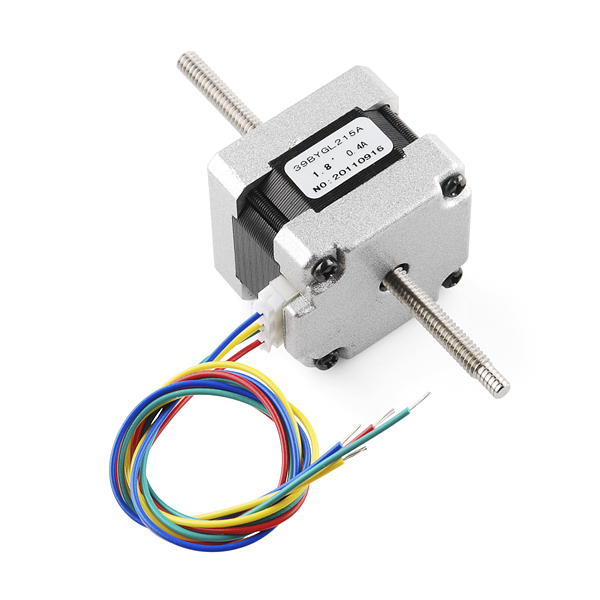
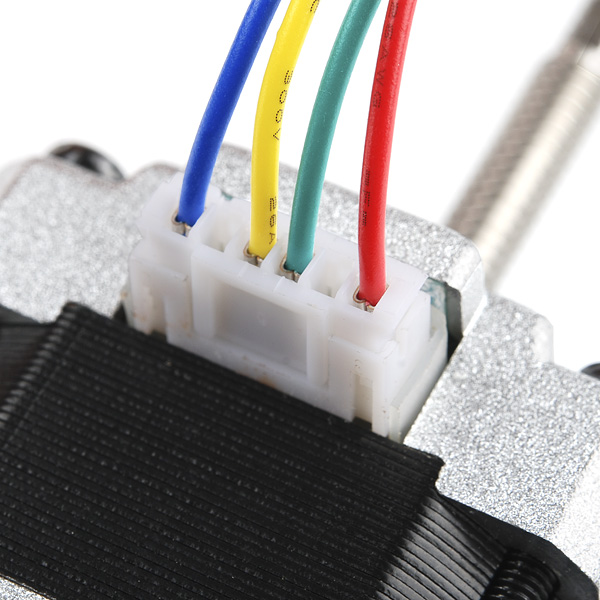
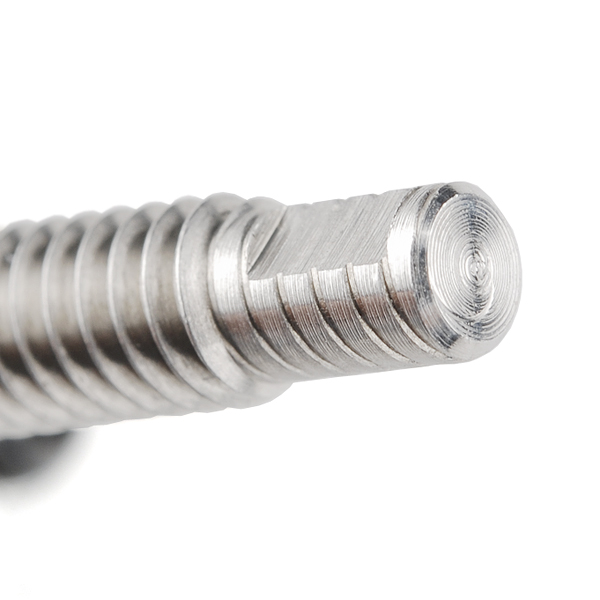
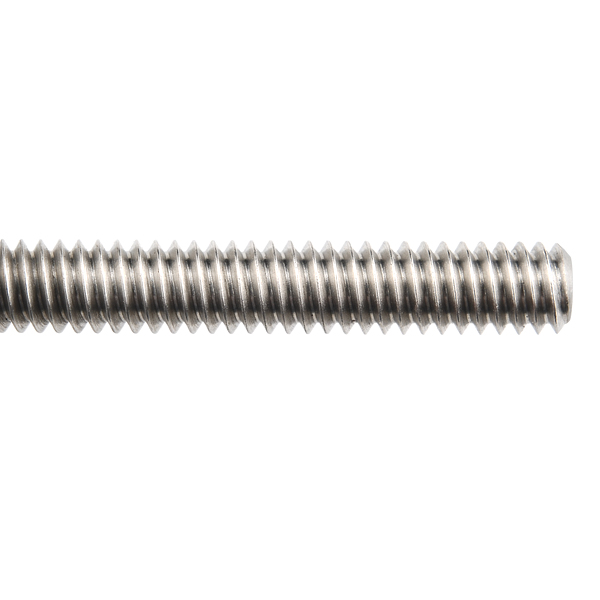
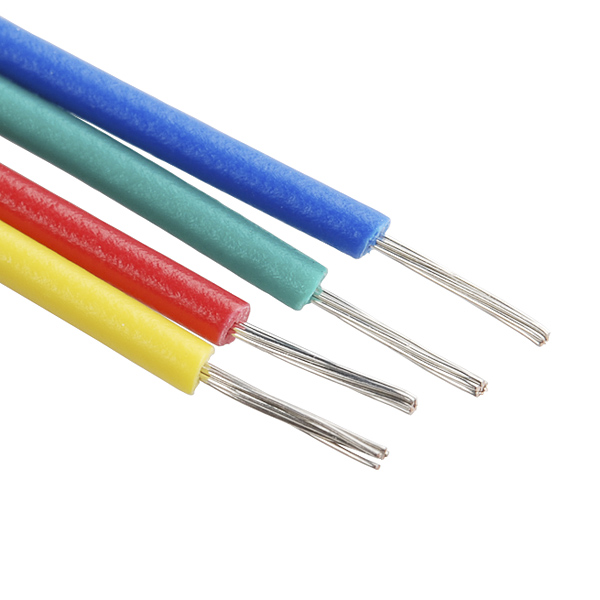
Hello - does sparkfun have a .step file CAD model of this motor? Would be useful to integrate it with a hobbyist CAD design that utilizes this part.
Plot twist - answered my own question. If anyone is looking for the CAD of this stepper motor and lead screw, checkout this link
Under the "Pipette Simple" folder, download:
It says NEMA 15...in the description. I think this is a mistake. Shouldn't it be NEMA 17?
Anyone know if these will run ok of 24v?
With the right driver set up to deliver no more than 400mA per phase, yes you can run these with 24 volts. An Easydriver should do the trick.
A lot of people have had questions about torque, direction, speed etc. with these. I've learned from experience that the general answer to this has to do with the current. Be sure there's not too much or too little current; it can generally be adjusted with a little pot on the stepper motor driver, like the EasyDriver.
How does one interface this rod with anything else? 5mm coupler? A nut? Is there a nut for this type of thread?
I say take it apart and machine the threaded hole to another size and something more common, they weren't thinking when they designed this.
i agree.
I allready ordered myself one of these.
Is it possible to take the included shaft out of the motor and insert a regular M5 threaded rod? This would be so brilliant for alot of robot applications when you dont want that coupling between the shaft and the threaded rod.
Good luck finding a 5mm threaded rod with a 2mm pitch.
Where do you get 2mm pitch? The picture looks like 0.8mm pitch, which is the standard coarse pitch for 5mm rod. Lots of 5x0.8mm rod at McMaster-Carr. The drawing says "M5*2(P1)", which is a little strange. I'm not sure what that is trying to say. But in the picture that sure isn't 2mm thread pitch. Maybe somebody at SparkFun could measure that with a thread gauge?
It could be a multi-start threaded rod: a double helix, each of which has a pitch of 1 mm. It's hard to tell from the photo, but it looks plausible. this is used to get faster travel, with less linear force, so 5 revolutions * 1 mm pitch * 2 starts = 10mm.
I just got mine, and can confirm that it is a 2-start threaded rod.
Hey! Thanks for checking that. Do you have a metric thread gauge? As sethcim says, 1mm pitch would make the math work out. Also, since this is a metric lead screw, I'm assuming it has a trapazoidal thread profile.
I've looked around for either rod or a threading die that has two starts at this pitch, but it seems like the standard 5mm multi-start lead screw is 4 start. In theory, of course, one could cut this rod on a lathe... but a long, 5mm diameter, hardened rod is going to be sooooo noodle-y it would take some skill to just cut a single start thread, much less precise multi-start threads.
mmmm... maybe... from the side picture it is hard to tell. The picture of the flatted end looks more like single start, but it is hard to tell.
The bottom line is that the spec sheet is so sketchy that you can't tell what you are buying when you get one of these. Sparkfun needs to clarify.
the data sheet says step distance of "0.01mm/step" and at 200 steps, that's 2mm per step and 1 cm per 5 steps. free cookie to first one to find a replacement(and longer) threaded rod? :P
I think you are correct. If you hold up a straight-edge to the photo, the top and bottom threads crest at the same point, so that would indicate two starts.
[edit]
So I spent some time googling to find a 5mm x 2 dual start trapezoidal threading die.... not much luck.
Hmmm.... M52(p1) == 5mm x 2 starts, pitch 1.0 --- suppose?
ondrives.com has *four start 5mm lead screws.
I think you mean 2mm per Rev, not per step :)
maybe the manufacturer can provide a longer threaded rod
yep, there's no reason why you couldn't use a longer shaft.
Except for being able to find one that fits....
now you have an excuse to buy that lathe you always wanted :-)
i just wanted to say... i love your beard man. Its like a grandfather/role-model to my beard. If i ever have a child, i will name it Robert's Beard. In honor of you. Thank you for being such an inspiration. <3
you're too kind, really. and you're welcome.
just to have 1 rod to be longer?
Thanks Robert. I would but... I already can't park any cars in my garage because of tools and workbenches. Besides, the last time I used the 13x40 lathe at the TechShop I threw a 1 pound chunk of aluminum into the chip tray and, um.... haven't yet gotten back on that horse :( That was a scary noise.
Using it as a linear actuator, what's the maximum weight a single motor could lift/push?
I tested it yesterday and it could push/pull about 20lbs max. No back-driving under that load either. (I used a Big Easy Driver)
This is a trapezoidal metric thread. Callout on the data sheet is incorrect. Should read Tr5x2(P1), where Tr designates a trapezoidal thread, and 5 is the nominal diameter in millimeters. When there is no suffix, e.g. Tr5x2, it is a single start thread and the value after the multiplication sign is the pitch. If there is a suffix, e.g. Tr5x2(P1), then the value after the multiplication sign is the lead and the value in the parentheses is the pitch. The number of starts is then calculated by dividing the lead by the pitch, in this case 2.
I have these motors running perfectly when held horizontally but they won't rotate and move up when held vertically. Does anyone have any suggestions?
First of all, I purchased one, checked it out, and found that the description above is NOT correct. The shaft moves 1cm per 10 full rotations (not 5). The pitch is 1mm. Size 5M (5mm diameter) And (bad news), I could not find 5M 1mm pitch screw anywhere. Not even any tap of that size. If any of you know any source where you can buy that size screw or tap, please let me know. That will be very helpful.
Does anyone know what would be a good driver for this motor or how to build the circuit from scratch. I used the EasyDriver and it didn't allow me to reverse the motor for some reason.
Just checking if any one has found a place to get these rods in greater lengths, say a foot? Otherwise does anyone have suggestions on how to move one of these motors to very specific locations along a X and Y axis?
I need this motor with more torque. Anybody know where I can find higher torque steppers with a "thru shaft"?
I've ordered 2 of those but the rods need to be longer.
I won't recommend buying those if you need longer rods. Or if spakfun finds some actual rods that are like 1 meter long. i've found some interesting steppers for you if you need them to be longer:
http://usautomation.com/VersaDrive17.aspx They have an anti-backlash mechanism and the rods are much longer. Also the motors are better. They work GREAT. I've given some feedback to spakfun, hope they add them to the products.
What linear force can the motor produce? That is, If I mounted the motor with the shaft vertical and secured a weight to the bottom end of the shaft, what is the maximum weight I could use before it would stall out?
Just got this stepper and it will work perfectly for my project. Stupid newbee question though: I found that if I run it at 5 volts, it is still plenty powerfull enough for what I need to do. Do I risk any damage by using this at 5v instead of 12v?
The shaft has a 1mm pitch. It's also stainless steel. That's because it runs through the center of the rotor magnets; if the shaft were made of a magnetic steel, it would become magnetized over time and that's usually a bad thing.
In searching for shaft material, I found no source of M5 X 1 stainless threaded rod, though I did find an alleged source of plain steel rod who didn't respond to my inquiries. You can have stainless rod threaded by a machine shop, but it's horrendously expensive.
It would be very useful for SparkFun to contact the motor vendor about the price to order custom lengths, perhaps a meter, then let us know how to order shafts from them.
My motor is tired of being a paperweight.
250mm Shafts are back in stock: http://www.tdvdesign.com/NEMA17Actuator250mmShaft/
I am willing to take a custom shaft order if the quantity is sufficient (10+), and have already taken one for 25 160mm shafts. Please keep in mind that these are not cheap to get custom made. Thanks, Tom
TDV, do you have any plans of ordering these again? Is the offer for custom shaft orders still available?
The shafts are in stock in my store, and custom orders are open. Thanks, Tom
What's your maximum length?
Wow. Good luck finding a longer rod. I ordered one of these and looked a lot of places trying to find one.
From what I can tell (from various shops looking at it, my own observations, and the datasheet), this requires a rod which is:
5mm diameter 2-start rod 1.0 mm pitch
Sadly, I even purchased an M5x1.0 die for cutting my own rod, only to discover fully the 2-start problem. A rough estimate from a local machine shop for a custom one came to about 4 hours of work @ $110/hour. This stepper is not worth $450 to me.
TL;DR: Get it if 100mm is good for you. Don't get it if you need a longer rod.
I have started stocking longer rods for this motor (250mm). If enough interest is shown, I can order even longer sections. These items are expensive, as they are custom made from the factory.
http://www.tdvdesign.com/NEMA17Actuator250mmShaft/
Tom
sorry but Could anyone find longer rod with same spec? I'm trying to fix rod and slide the motor. I believe it works same as other stepper motor and works well with given Bldr tutorial (from EasyDriver v4) but need longer rod :(
We ALL need longer rods but the threads are so uncommon, you'd be better off with some serious power. These are pretty good: http://usautomation.com/VersaDrive17.aspx
Hey, does anyone know the speed of this stepper motor?
Hi, I've got this linear stepper motor and bigeasy driver. I couldnt make this thing turn. When I send step signals It just vibrates. I tried really slow signals as well as faster frequency but no help. The connections seems right as well. what makes this wrong?
Do you have enough power? what's your power supply?
It seems that the pin outs on the datasheet might be incorrect. You may have to just plug around until it works properly.
Also, the delay in your code may need adjusting for this stepper motor. If the delay is too short, it just vibrates and does not go anywhere.
Been experimenting with driving this stepper. EasyDriver not consistent in both directions. Moves nicely in one direction but just vibrates when reversed. Any other experience with EasyDriver? Used example from bildr to check out.
I'm having the same problem were you able to fix it?
Never found fix. Gave up on stepper motor. Wound up using Bimba pneumatic actuator for application. Good luck. If you find fix please post it.
The problem was, in my case, that I needed to switch the yellow and green leads. but It still doesn't have enough to go up against gravity.
what voltage are you using for the stepper motor?
12V from a computer Power Supply
steppers are tricky. Check out this page from Geckodrive, maker of high-end stepper driver boards. Check out the equation for determining optimum voltage to power a stepper. Although steppers have 'ratings' they are oftentimes driven with higher voltage to get maximum torque. The equation is the square root of the inductance, times 32. For this motor, you're looking at over 200 volts! You can easily use a higher voltage supply to get more torque from the motor. That same link has a lot of very useful information about steppers, and driving them.
BTW those interested in alternate rods, you might be able to find something that will fit from McMaster Carr http://www.mcmaster.com/#acme-rods/
I'm guessing you didn't go look there yourself. Go try it. Go try Small Parts, too. Or Maryland Metrics. Or Misumi USA. Besides, it won't be an acme rod, acme is used for imperial lead screws. Metric lead screws use trapezoidal thread.
How the hell does this sell out after 2 days?
This probably tells a little about how much we Sparkfun customers demand more stepper motors and especially motors that makes it easier to interface directly with other elements as rods, and other mechanical things without having to use a coupling.
Hmm.. Long term accuracy and durability of the threaded rod might be a concern. Would of been nice if they used an Acme thread instead of the standard V. For those of you who need accuracy, don't forget to take into account screw backlash when reversing directions. Highly doubt they used anti backlash nuts in the design
no antibacklash I can see in there, just the one rod that appears to be 2 starts (rod definitely moves faster than a normal thread). Its a bit on the wobbly side.
eh well, no. A trapezoid thread is going to perform about like an acme lead screw, which is not bad, but not as precise as a ball screw.
If it really is a multi-start rod, then it is probably a trapezoidal thread. I see they are sold out right now -- maybe someone that bought one can measure it for us.
I will meassure and test mine with a regular m5 rod when it arrives in a few weeks
so i got mine now, and tested it with a M5 nut. As someone else have said allready there is no standard threading on the rods as there is 2mm pitch or something. To bad. Sparkfun, please get one with standard threading. M6 have 1mm threads, use that! ;)
i may or may not have gotten the last two - but once they come i'll take a close look at them and measure them
haha, this is hilarious. just last week i started looking into using stepper motors from you guys for a robot arm project i'm working on for school. and i've designed it so that the motor turns a threaded rod to act as a linear actuator
You could also get a linear actuator from Firgelli in Victoria BC or Firgelli Auto in WA or UltraMotion (if you have more money than god)
nice product. very usefull.